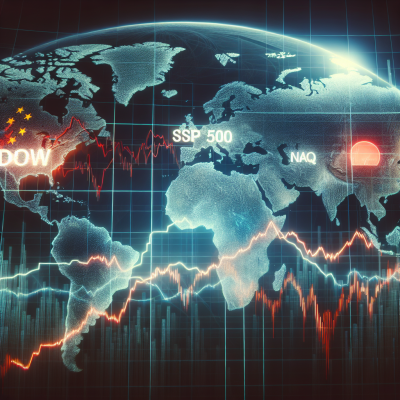
Markets React Sharply as China Strikes Back with Retaliatory Tariffs
The financial world was rocked early Monday as U.S. stock futures fell sharply in response to China’s announcement of its first round of retaliatory tariffs following the recent escalation in trade tensions. The move sent the Dow Jones Industrial Average, the S&P 500, and the Nasdaq Composite plunging, highlighting investor fears that the trade war between the world’s two largest economies is far from over.
What Triggered the Market Sell-Off?
Over the weekend, China announced a new set of import duties in direct response to the recent tariffs imposed by the U.S. These fresh levies, seen by market observers as aggressive retaliation, target a range of American goods from agricultural products to technology components. The announcement came just days after President Trump unveiled an expansive plan for reciprocal tariffs aimed at curbing what he described as “unfair trade practices” by China.
Investors were quick to react, interpreting China’s move as a serious escalation that could lead to prolonged economic disruption. As a result:
- The Dow fell by more than 600 points in early trading.
- The S&P 500 dropped nearly 2% before noon.
- The Nasdaq Composite, heavily weighted toward technology stocks, tumbled over 3% at its low point.
Global Impact and Investor Jitters
The ramifications weren’t limited to Wall Street. Global markets from London to Tokyo experienced disruptions, with major indices reflecting a sudden shift to risk aversion. Safe-haven assets such as gold and U.S. Treasury bonds saw gains as investors fled equities.
Wall Street analysts were quick to caution that this could mark a turning point in the trade war narrative. While previous tariff exchanges were met with volatility followed by relative stability, this round underscored the increasingly adversarial nature of U.S.–China relations.
“We’re no longer just seeing tit-for-tat tariffs,” said one analyst from Goldman Sachs. “We’re in a phase where both sides are preparing for a long economic standoff.”
Which Sectors Were Hit the Hardest?
The tariffs imposed by China were surgical in their approach—targeting key American sectors with strong political connections, including agriculture, technology, and manufacturing.
- Technology: Semiconductor and hardware companies saw sharp declines, with shares of Nvidia, AMD, and Apple leading the dip on the Nasdaq.
- Agriculture: U.S. farm commodities, including soybeans, wheat, and pork, took an immediate hit, fueling concerns about America’s rural economy.
- Industrial Goods: Companies like Caterpillar and Boeing were also among the top Dow losers, reflecting worries over exports to China and weakened global demand.
White House Response and Forward Guidance
Shortly after the markets began to crater, the White House issued a statement defending the administration’s trade strategy. President Trump insisted that the U.S. would not back down in the face of Chinese retaliation, arguing that America “must protect its interests and its future.”
However, the lack of a clear resolution or roadmap to negotiations left markets anxious. Traders and economists now believe that the probability of a full-scale economic slowdown has increased dramatically, with many revising their growth forecasts downward for the remainder of the year.
Is a Recession Looming?
Although it’s too early to declare an economic recession, the stock market’s activity signals that investors are bracing for turbulence. Bond yields fell and the yield curve inverted briefly—two indicators that traditionally precede economic slowdowns.
Economic strategists are urging caution as trade uncertainty could weigh on corporate earnings and consumer confidence in the months ahead.
What Should Investors Do Now?
Financial advisors are recommending a balanced approach in light of growing volatility:
- Diversify: Ensure your portfolio isn’t overly concentrated in sectors vulnerable to trade shocks.
- Watch the Fed: Investors are speculating that additional rate cuts may be on the table to sustain economic growth amid trade tensions.
- Focus on Fundamentals: Avoid reactive trading and instead focus on companies with strong balance sheets and global resilience.
Conclusion
The sharp downturn across major indices following China’s retaliatory tariffs is a stark reminder that the global economy remains delicately balanced. Investors, policymakers, and businesses alike will be watching closely for signs of de-escalation or further escalation in the coming weeks. As Wall Street recalibrates to a new reality of heightened uncertainty, the question remains: how far will each side go in this growing trade confrontation?
Stay tuned to market updates and expert analysis to navigate these turbulent financial waters.


Leave a Reply